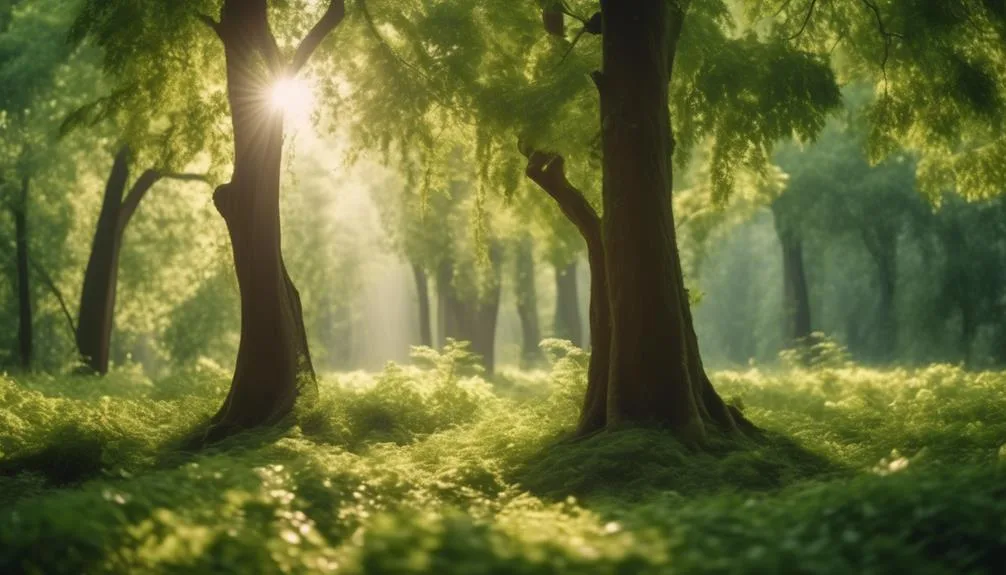Elm trees can be challenging to grow, but they can thrive in the right conditions. From the majestic American Elm to the graceful Lacebark Elm, these trees have specific needs for healthy growth and longevity.
Understanding the ideal conditions for elm trees, such as climate, soil, sunlight, and water, is crucial for successful cultivation. How can you create the perfect environment for these magnificent trees to flourish?
Climate Requirements
To successfully grow healthy elm trees, you need to choose a climate that provides adequate sunlight, moderate temperatures, and well-draining soil.
Elm trees have a temperature tolerance that allows them to thrive in a wide range of climates, from hot summers to cold winters. They can withstand temperatures as low as -30°F (-34°C) and as high as 100°F (38°C), making them adaptable to various regions.
When considering rainfall patterns, elm trees prefer moderate to high rainfall, but they can also withstand periods of drought once established. They thrive in areas with well-distributed rainfall throughout the year, but they can also survive in regions with distinct wet and dry seasons.
Consider these temperature and rainfall factors when choosing the best climate for growing healthy elm trees.
Soil Conditions
When considering the ideal climate for healthy elm trees, it's crucial to pay attention to the soil conditions that will support their growth and vitality.
Elm trees have a deep root system, so the soil needs to be well-draining and deep to accommodate their root depth. Ideally, the soil should be loamy, providing a balance of sand, silt, and clay, allowing for good drainage while retaining enough moisture for the elm trees.
Additionally, elm trees require soil with adequate nutrient levels, particularly nitrogen, phosphorus, and potassium. These nutrients support healthy growth and help the trees resist diseases. Testing the soil and amending it with organic matter or fertilizers can ensure that the elm trees have the necessary nutrients for optimal growth.
Sunlight Needs
For healthy elm trees, ensure they receive ample sunlight to thrive and flourish in your environment. Elm trees typically thrive in full sunlight, requiring at least six hours of direct sunlight each day.
When planting elm trees, consider the surrounding tree canopy to ensure they aren't overshadowed. While young elm trees are more tolerant of partial shade, mature elms require abundant sunlight to maintain their health and vigor. In shaded areas, elm trees may struggle to develop a robust canopy and could become more susceptible to diseases and pests.
Therefore, when selecting a location for planting elm trees, prioritize areas with good sun exposure to promote their growth and longevity. Remember, adequate sunlight is essential for elm trees to thrive and contribute to the beauty of your landscape.
Watering and Drainage
Consider the soil moisture and drainage capabilities in the area where you plan to plant your elm trees to ensure they thrive in optimal conditions. Proper watering and drainage are crucial for root health and overall tree vigor.
Elm trees prefer well-draining soil to prevent waterlogged conditions that can lead to root rot. When watering, aim for deep, infrequent watering rather than frequent shallow watering to encourage deep root growth. This helps the tree withstand drought conditions and promotes stability.
Additionally, proper drainage prevents water from pooling around the roots, which can lead to suffocation and disease. When applying fertilizer, be mindful of the water-soluble nutrients and their potential impact on drainage.
Geographic Regions
Are you aware of the geographic regions where elm trees grow best? Elm trees are native to various regions across North America, Europe, and parts of Asia. They thrive in temperate climates with distinct seasons, making them well-suited for areas with cold winters and warm summers. Urban environments, such as city streets and parks, also provide ideal growing conditions for elm trees due to their adaptability to different soil types and tolerance to pollution. Below is a table outlining some of the native habitats where elm trees grow best:
| Region | Climate | Soil Type |
|---|---|---|
| North America | Temperate | Well-drained |
| Europe | Temperate | Loamy |
| Asia | Temperate | Sandy |
Elm trees have historically thrived in these regions, and their ability to adapt to urban environments makes them a popular choice for city landscaping.
Conclusion
In the right climate and soil conditions, with proper sunlight and moisture, elm trees can flourish and enhance the natural beauty of any environment.
Happy planting!

My interest in trees started when I first saw the giant sequoias in Yosemite.
I was a teenager then, and I remember thinking, “I need to learn more about this.”
That moment stuck with me.
A few years later, I went on to study forestry at Michigan Tech.
Since graduating, I’ve worked in a mix of hands-on tree care and community education.
I’ve spent over ten years helping people understand how to plant, maintain, and protect the trees in their neighborhoods.
I don’t see trees as just part of the landscape.
They are living things that make a real difference in our daily lives.
